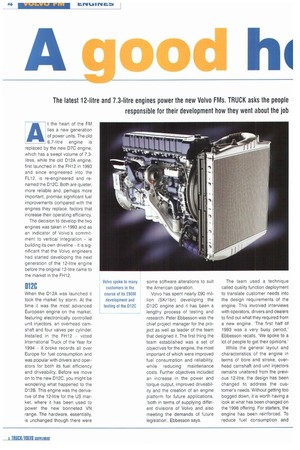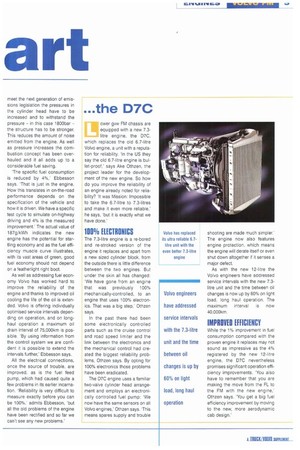A CiOnt hi
Page 104

Page 105

If you've noticed an error in this article please click here to report it so we can fix it.
art
The latest 12-litre and 7,3-litre engines power the new Volvo FMs. TRUCK asks the people responsible for their development how they went about the job At the heart of the FM lies a new generation of power units. The old
6 7-litre engine is replaced by the new 07C engine, which has a swept volume of 7.3litres, while the old D12A engine, first launched in the FH12 in 1993 and since engineered into the FL.12. is re-engineered and renamed theD12C. Both are quieter, more reliable and. perhaps more important, promise significant fuel improvements compared with the engines they replace, factors that increase their operating efficiency.
The decision to develop the two engines was taken in 1993 and as an indicator of Volvo's commitment to vertical integration ie building its own driveline it is significant that the Volvo engineers had started developing the next generation of the 12-litre engine before the original 12-litre came to the market in the FH12.
1112C
When the 012A was launched it took the market by storm. At the time it was the most advanced European engine on the market, featuring electronically controlled unit injectors, an overhead camshaft and four valves per cylinder. Installed in the FH12 voted International Truck of the Year for
1994 it broke records all over Europe for fuel consumption and was popular with drivers and operators for both its fuel efficiency and idriveability. Before we move on to the new 012C, you might be wondering what happened to the 012B. This engine was the derivative of the 12-litre for the US market, where it has been used to power the new bonneted VN range. The hardware, essentially, Is unchanged though there were
some software alterations to suit the American operation.
Volvo has spent nearly £90 million (SKr1bn) developing the 012C engine and it has been a lengthy process attesting and research. Peter Ebbesson was the chief project manager for the project as well as leader of the team that designed it. The first thing the team established was a set of objectives for the engine, the most important of which were improved fuel consumption and reliability, while reducing maintenance costs. Further objectives included an increase in the power and torque output. improved driveability and the creation of an engine platform for future applications, 'both in terms of supplying different divisions of Volvo and also meeting the demands of future legislation'. Ebbesson says. The team used a technique called quality function deployment to translate customer needs into the design requirements of the engine. This involved interviews with operators, drivers and dealers to find out what they required from a new engine. The first half of 1993 was a very busy period,' Ebbesson recalls. We spoke to a lot of people to get their opinions.'
While the general layout and characteristics of the engine in terms of bore and stroke, overhead camshaft and unit injectors remains unaltered from the previous 12-litre, the design has been changed to address the customer's needs. Without getting too bogged down, it is worth having a look at what has been changed on the 1998 offering. For starters, the engine has been reinforced. To reduce fuel consumption and meet the next generation of emissions legislation the pressures in the cylinder head have to be increased and to withstand the pressure in this case 1800bar the structure has to be stronger. This reduces the amount of noise emitted from the engine. As well as pressure increases the combustion concept has been overhauled and it all adds up to a considerable fuel saving.
The specific fuel consumption is reduced by 4%, Ebbesson says. That is just in the engine. How this translates in on-the-road performance depends on the specification of the vehicle and how it is driven. We have a specific test cycle to simulate on-highway driving and 4% is the measured improvement.' The actual value of 187g/kWh indicates the new engine has the potential for startling economy and as the fuel efficiency muscle curve illustrates, with its vast areas of green, good fuel economy should not depend on a featherlight right boot.
As well as addressing fuel economy Volvo has worked hard to improve the reliability of the engine and thanks to improved oil cooling the life of the oil is extended. Volvo is offering individually Optimised service intervals depending on operation, and on longhaul operation a maximum oil drain interval of 75,000km is possible, `By using information from the control system we are confident it is possible to extend the intervals further,' Ebbesson says.
All the electrical connections, once the source of trouble, are improved, as is the fuel feed pump, which had caused quite a few problems in its earlier incarnation. 'Reliability is very difficult to measure exactly before you can be 100%,' admits Ebbesson, but all the old problems of the engine have been rectified and so far we can't see any new problems.'
















































































































